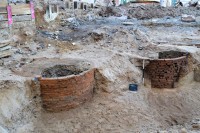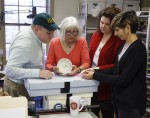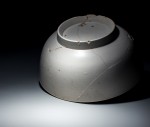The Chinese figured out how to make hard-paste or true porcelain, the finest ceramic known for its hardness and translucency, in the 7th century. It would take almost another thousand years, in the 16th century under the Ming Dynasty, for fine Chinese porcelain to be exported to Europe in significant quantities. There it was admired and puzzled over. European ceramicists tried to crack the code — the combination and quantity of raw materials, the firing temperature — but failed. Only in the 18th century did Johann Friedrich Böttger, at the behest of Augustus II the Strong, Elector of Saxony, solve the mystery of hard-paste porcelain. The Meissen factory, founded in 1710, was the first European producer.
 That wasn’t the end of the story, however. In the American colonies, particularly in the southern states, experimentation with porcelain took off in the 1730s, and continued for decades. There is documentary evidence of the study and eventual production of China in America, but no actual evidence of 18th century hard-paste porcelain in the archaeological record. The excavations at the site of the new Museum of the American Revolution in Philadelphia in 2014 finally found that evidence.
That wasn’t the end of the story, however. In the American colonies, particularly in the southern states, experimentation with porcelain took off in the 1730s, and continued for decades. There is documentary evidence of the study and eventual production of China in America, but no actual evidence of 18th century hard-paste porcelain in the archaeological record. The excavations at the site of the new Museum of the American Revolution in Philadelphia in 2014 finally found that evidence.
The survey of the museum site has proven to be one of the greatest archaeological bonanzas in American history, and so deliciously on topic to the institution that will open in historic downtown Philadelphia on April 19th, 2017. The behind-the-scenes hero of the piece is, yet again, poop. Archaeologists unearthed 12 brick-lined outhouse vaults packed with artifacts from the first decade of the 18th century through the mid-19th century. Private residents, shops and hostelries all used the privies as trash cans as well as toilets for 150 years or so, leaving 21st century archaeologists almost 85,000 artifacts to sort through.
 One of the 85,000 is a small white punch bowl, unearthed in fragments in 2014. Archaeologists from Commonwealth Heritage Group initially thought the bowl was a piece of white stoneware, but a recent material analysis by Saint Mary’s University geologist Dr. J. Victor Owen, an expert on archaeological ceramics and glass, found that the bowl is true-porcelain, probably manufactured in Philadelphia.
One of the 85,000 is a small white punch bowl, unearthed in fragments in 2014. Archaeologists from Commonwealth Heritage Group initially thought the bowl was a piece of white stoneware, but a recent material analysis by Saint Mary’s University geologist Dr. J. Victor Owen, an expert on archaeological ceramics and glass, found that the bowl is true-porcelain, probably manufactured in Philadelphia.
“One of the most intriguing stories in the world of ceramic history is the search for the secrets of making hard-paste porcelain,” said Robert Hunter, editor of Ceramics in America and an author and archaeologist. “The search, however, for physical evidence of making true porcelain in 18th century America has been frustratingly unsuccessful – until now. The discovery of this bowl is like finding the holy grail of American ceramics, and is a thrilling addition to the history of the American effort to produce this coveted material.”
It also has direct relevance to the theme of the Museum of the American Revolution, because buying domestic, even for luxury goods, was a political statement in the lead-up to the Revolution.
“The discovery of this remarkable little bowl reminds us that the ‘buy local’ movement has very deep roots in American history,” said Dr. R. Scott Stephenson, Vice President of Collections, Exhibitions, and Programming at the Museum of the American Revolution. “It is also an important reminder that when colonists boycotted imported British goods as a way to protest Parliamentary taxation, they did not have to settle for crude versions of beloved luxuries from abroad. Colonial tradespeople produced elegant textiles and ceramics for a market eager use the ‘power of the purse’ to make a political point.”
 A report on the discovery and analysis of the punch bowl will be published in the January issue of Ceramics in America. The little broken white Holy Grail will go on permanent display in the “homespun” gallery of the new museum when it opens this Spring, but will make its first public appearance at the New York Ceramics and Glass Fair this month. Co-author of the article Robert Hunter will be giving a lecture at the fair on the quest to make true porcelain in 1700s America and how the Philadelphia punch bowl fits into that history on Thursday, January 19th.
A report on the discovery and analysis of the punch bowl will be published in the January issue of Ceramics in America. The little broken white Holy Grail will go on permanent display in the “homespun” gallery of the new museum when it opens this Spring, but will make its first public appearance at the New York Ceramics and Glass Fair this month. Co-author of the article Robert Hunter will be giving a lecture at the fair on the quest to make true porcelain in 1700s America and how the Philadelphia punch bowl fits into that history on Thursday, January 19th.